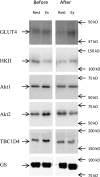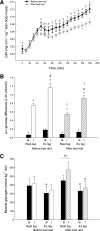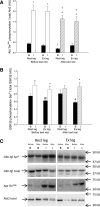GLUT4 and glycogen synthase are key players in bed rest-induced insulin resistance
- PMID: 22403297
- PMCID: PMC3331744
- DOI: 10.2337/db11-0884
GLUT4 and glycogen synthase are key players in bed rest-induced insulin resistance
Abstract
To elucidate the molecular mechanisms behind physical inactivity-induced insulin resistance in skeletal muscle, 12 young, healthy male subjects completed 7 days of bed rest with vastus lateralis muscle biopsies obtained before and after. In six of the subjects, muscle biopsies were taken from both legs before and after a 3-h hyperinsulinemic euglycemic clamp performed 3 h after a 45-min, one-legged exercise. Blood samples were obtained from one femoral artery and both femoral veins before and during the clamp. Glucose infusion rate and leg glucose extraction during the clamp were lower after than before bed rest. This bed rest-induced insulin resistance occurred together with reduced muscle GLUT4, hexokinase II, protein kinase B/Akt1, and Akt2 protein level, and a tendency for reduced 3-hydroxyacyl-CoA dehydrogenase activity. The ability of insulin to phosphorylate Akt and activate glycogen synthase (GS) was reduced with normal GS site 3 but abnormal GS site 2+2a phosphorylation after bed rest. Exercise enhanced insulin-stimulated leg glucose extraction both before and after bed rest, which was accompanied by higher GS activity in the prior-exercised leg than the rested leg. The present findings demonstrate that physical inactivity-induced insulin resistance in muscle is associated with lower content/activity of key proteins in glucose transport/phosphorylation and storage.
Figures





References
-
- Venables MC, Jeukendrup AE. Physical inactivity and obesity: links with insulin resistance and type 2 diabetes mellitus. Diabetes Metab Res Rev 2009;25(Suppl. 1):S18–S23 - PubMed
-
- Chen YD, Golay A, Swislocki AL, Reaven GM. Resistance to insulin suppression of plasma free fatty acid concentrations and insulin stimulation of glucose uptake in noninsulin-dependent diabetes mellitus. J Clin Endocrinol Metab 1987;64:17–21 - PubMed
-
- King DS, Dalsky GP, Clutter WE, et al. Effects of exercise and lack of exercise on insulin sensitivity and responsiveness. J Appl Physiol 1988;64:1942–1946 - PubMed
-
- Mikines KJ, Richter EA, Dela F, Galbo H. Seven days of bed rest decrease insulin action on glucose uptake in leg and whole body. J Appl Physiol 1991;70:1245–1254 - PubMed
Publication types
MeSH terms
Substances
LinkOut - more resources
Full Text Sources
Medical
Molecular Biology Databases
Miscellaneous

